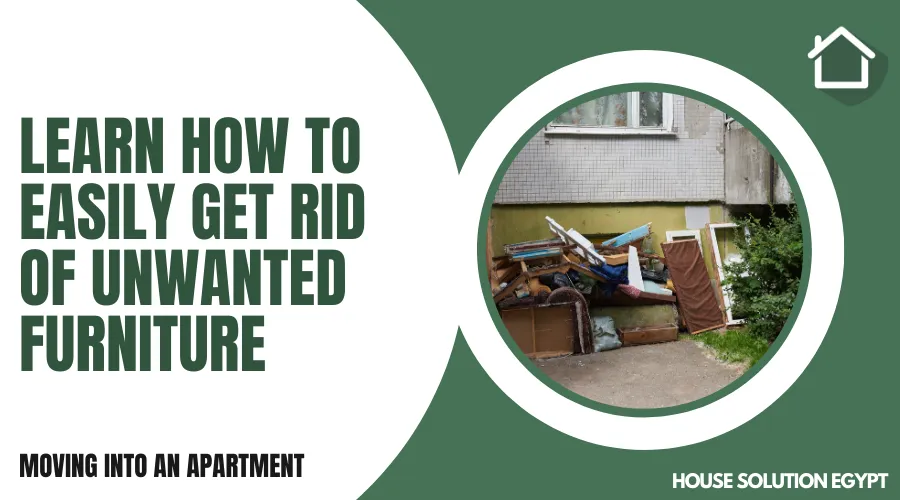WHAT HAPPENS WHEN YOU LEAVE YOUR FURNITURE BEHIND?
Moving into an Apartment|3.8 MIN READ|Updated on: 24 December 2024|Written by: Marwa Samir
When you move from one place to another, it's not uncommon to leave behind a piece of furniture or two that you can't fit in your new space. However, what many people don't realize is that leaving furniture behind can lead to a variety of consequences. Firstly, if the abandoned furniture is in good condition, it could be resold or donated to someone who needs it. Leaving behind such items means missing out on an opportunity to help others.
Abandoned furniture can create an eyesore and reduce the value of your property. If left outside for too long, it could also become a hazard and cause accidents that are potentially life-threatening. Finally, there are environmental impacts to consider; irresponsible disposal of unwanted furniture fills up landfills at an alarming rate and contributes significantly to pollution.
Leaving behind furniture may seem like a small issue but has far-reaching implications beyond simply not having enough space in your new home. It's important always to dispose of unwanted items responsibly or donate them when possible instead of leaving them behind for someone else to deal with.
Moisture Damage:
Moisture damage is one of the common issues that can arise when furniture is left behind. Moisture, whether it comes from humidity or flooding, can cause serious harm to your furniture if left unchecked. Wooden furniture will begin to rot and warp if exposed to moisture for an extended period of time, while metal furniture will rust and corrode.
Furthermore, moisture damage in your furniture can also lead to mold growth. Mold spores are present everywhere in the environment but thrive in damp environments. When mold grows on your furniture, it not only causes discoloration and odor but also poses a threat to health. It's important to address moisture damage promptly once you notice it because mold growth can occur quickly.
If you're leaving your furniture behind for an extended period of time or storing it away during a move, make sure it's properly protected from moisture by using dehumidifiers, placing desiccant packets near the items or wrapping them up tightly with waterproof materials. Taking these precautions prevents expensive damage and ensures that they remain in good condition until you return or relocate them elsewhere.
Pests and Insects:
When leaving furniture behind, pests and insects are often attracted to the space. Termites, cockroaches, and bed bugs are some of the most common pests that can infest abandoned furniture. These critters are known for breeding quickly, and before you know it, they’ve infested other areas of your home as well.
Termites have a voracious appetite for wood furniture and can cause severe damage if left unchecked. They burrow deep into the wood, making it weak from the inside out. Cockroaches also love to make their homes in abandoned furniture because it provides them with a warm place to hide during the day while they come out at night scavenging for food.
Bed bugs are another pest that loves to make its home in abandoned furniture. They’re small enough to hide in crevices and corners where they can lay eggs undisturbed. Once these eggs hatch, you’ll be dealing with an infestation that is difficult to eradicate without professional help.
Neglecting your old or unwanted furniture could lead to severe pest problems down the line. It’s important always to dispose of old items properly rather than leaving them on the sidewalk or in storage units where they may attract unwanted visitors.
Mold Growth:
When you leave your furniture behind, it becomes an easy target for mold growth. Mold thrives in damp and humid environments, making abandoned furniture a perfect breeding ground for spores. As moisture accumulates over time, mold can begin to grow on the surface of the furniture and even penetrate deep into the upholstery or wood.
Mold can be harmful to both your health and the structural integrity of your furniture. The spores released by mold can cause respiratory issues such as coughing, wheezing, and asthma attacks. Additionally, mold can weaken the structure of your furniture by breaking down its fibers or causing rotting.
To minimize mold growth on neglected furniture, it is important to keep it dry and free from moisture buildup. This can be achieved by storing it in a dry place with proper ventilation or using a dehumidifier. If you suspect that you have mold growing on your furniture, it is best to consult with a professional who can safely remove it without damaging your belongings or putting yourself at risk of inhaling harmful spores.
Warping and Deterioration:
Warping and deterioration are two of the most common issues that furniture owners face when they leave their belongings behind. When exposed to the elements, wooden furniture can warp due to changes in temperature and humidity. This warping can cause cracks, splits, or even complete breakage in some cases. Similarly, metal furniture can rust and corrode over time if left outside.
Deterioration is another problem that arises when furniture is left behind. Mold, mildew, and other fungi can grow on fabric upholstery if it is not properly cleaned before storage. Additionally, insects like termites and ants can damage wooden furniture by burrowing into it and eating away at the wood fibers. Even leather upholstery is not immune to deterioration - if left in a damp environment for too long it can crack or rot.
Leaving your furniture behind without proper preparation or storage measures can lead to warping and deterioration problems that may be irreversible. To avoid these issues altogether, it's best to take proper precautions before storing your items for an extended period of time.
Unpleasant Odors:
When you leave your furniture behind, the chances are that it will be exposed to various elements such as dust, moisture, and pests. These factors can lead to the development of unpleasant odors in your furniture. The longer the furniture stays unattended, the more intense these odors become.
The accumulation of dust on your furniture can cause musty smells that are not only unpleasant but also harmful to your health. Dust contains allergens and other harmful substances that can trigger respiratory illnesses such as asthma and allergies. Moisture is another culprit responsible for bad odors in abandoned furniture. When wood absorbs excess moisture from the environment or spills, it becomes a breeding ground for mold and mildew that produce a pungent smell.
Pests such as rodents, insects, and even pets can also contribute to foul odors in left-behind furniture. Urine stains from pets or rodents can penetrate deep into cushions or fabric leading to an unbearable smell that lingers long after cleaning. Insects such as cockroaches thrive on decaying matter including food crumbs stuck between cushions leading to a putrid odor in neglected spaces over time.
Conclusion:
In conclusion, leaving your furniture behind can have several negative consequences. First and foremost, it can be a waste of money as you will need to purchase new furniture when you move into your new home. Additionally, leaving furniture behind may result in damage to the property or injury to others if the items are not properly disposed of.
Furthermore, abandoning furniture can harm the environment as much of it ends up in landfills where it contributes to pollution and takes up valuable space. It is important to consider donating unwanted furniture to local charities or recycling centers instead.
In conclusion, taking the time and effort to properly dispose of unwanted furniture can benefit both yourself and the environment. By doing so, you can avoid unnecessary expenses and ensure that your old belongings are put to good use rather than being left to rot in a landfill.






